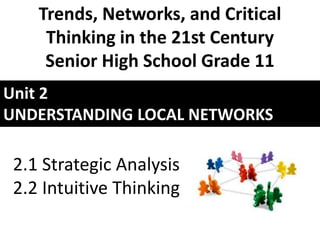
Trends, Network and Critical Thinking 2 Understanding Local Networks
- 1. Unit 2 UNDERSTANDING LOCAL NETWORKS Trends, Networks, and Critical Thinking in the 21st Century Senior High School Grade 11 2.1 Strategic Analysis 2.2 Intuitive Thinking
- 2. Networks and Linkages: Introduction The school can enjoy linkages and networking activities with international, national and local organizations in the community for mutual benefits and assistance needed.
- 3. Linkage and networking are different in the degree of commitment by the partners. In linkage, the relationship between partner organizations is quite loose, while in networking, it is much stronger, usually because the groups and agencies have common objectives and beneficiaries. Networking is basically extending the outreach of the resources in different ways so as to increase the effectiveness of the program.
- 4. Networks • A relationship structure wherein the members of the network are able to share resources with one another. • A network is composed of several institutions (consortium) of several colleges of different universities that bind together for a common goal. • Work together to attain common objectives, undertake innovative practices and update members regarding breakthrough in different disciplines.
- 5. Kinds of Networks: 1. Human Network 2. Knowledge Network 3. Computer Network 4. Trade Network 5. Ecological Network
- 6. Linkages • Intends to serve members of both sides according to their respective needs, interest, and objectives • Create bonds together to solicit support and assistance for purposeful activities
- 7. National and Local Linkages • It is established between universities and colleges offering identical degrees in which cross-enrolment for subjects needed for graduation is allowed. • It is also a joint researches that could be conducted by two or three universities depending on their field of expertise
- 10. Networks can be considered as linkages if they link one network to another creating a bigger network.
- 11. 3 Categories of Social Network: a. Family b. Peers c. Contacts
- 12. 3 Categories of Social Network: a. Family – first sphere of our social network - first group of individuals with whom we establish social relations - they ensure our survival after we are born
- 13. b. Peers – we met them through our family (family friends, acquaintances of siblings, neighbors), while others we meet on our own (classmates, officemates, church mates, etc) - they can provide help not provided by family.
- 14. c. Contacts – provide things neither our families nor friends provide Ex. Delivery boy, tindera, teachers, doctors, etc.
- 15. Family Relations based on the Family Code of the Philippines 1. Husband and Wife 2. Parents and children 3. among descendants and ascendants 4. among brothers and sisters, full or half-blood
- 16. Rules to Remember on Family Relations (Family Code) 1. Family relations exist among the relatives aforementioned even if they are not living together. 2. Other relatives like cousin, nephews, nieces and domestic helpers who grew up and are living together with the family are members of the household but not of the family. 3. Illegitimate children are not included in the family relations because they have their own family.
- 17. 4. Adopted children being part of the family are included. 5. Nephews and nieces, uncles and aunts are not included because they have their own families. 6. Relatives mentioned in the article include those of the husband and wife.
- 18. The notion/idea of the family may include a lot more than what is stipulated in the law • Pets as part of the family • Best friends • Work place, colleagues, communities, school, church etc.
- 19. STRATEGIC ANALYSIS Strategy - from Greek work “Strategia”, meaning skills possessed by generals and are necessary to win battles Analysis - careful study of each part of a whole and understanding how each part and their relationships with each other result in the world.
- 20. Strategic Analysis - involved examination and evaluation of strengths, weakness, opportunities, threats, environments and resources, with the purpose of drawing up a strategy from the results of the analysis to achieve certain goals over time. - the use of Logic
- 21. SWOT ANALYSIS - an incredibly simple, yet powerful tool to help you develop your strategy. SWOT stands for Strengths, Weaknesses, Opportunities, and Threats.
- 23. Strengths and Weaknesses—internal things that you have some control over and can change. Opportunities and Threats — are external, things that are on the outside. You can take advantage of opportunities and protect against threats, but you can’t change them.
- 24. Example: Choosing which school to enroll in college Use strategic analysis - personal interest - courses available - strengths and weakness of the school - capacity to pay - distance - etc.
- 25. INTUITIVE THINKING - the kind of thinking that helps you understand reality in the moment, without logic or analysis. There's no language involved in it, either. It's entirely about signs and sensations. Most of the time, it goes against whatever we might think of as “rational”. It is more of familiarity and experience.
- 26. Intuition - is a form of knowledge that appears in consciousness without obvious deliberation. Hunches (“kutob”) are generated by the unconscious mind rapidly sifting through past experience and cumulative knowledge. - Not a result of a process of analysis and deliberation but that of quick and reflexive thinking to give immediate response.
